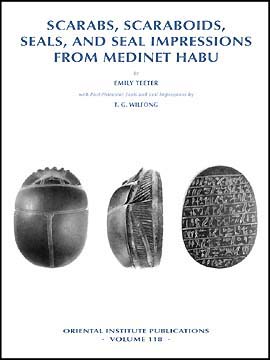OIP 118. Scarabs, Scaraboids, Seals, and Seal Impressions from Medinet Habu Emily Teeter, with a contribution by T. G. Wilfong

Purchase Download Terms of Use
Medinet Habu in western Thebes (modern Luxor) is among the most important sites in Egypt. It is dominated by the great mortuary temples of King Ramesses III (ca. 1182 BC) and Kings Aye and Horemheb (ca. 1324–1293 BC). It served as the seat of the regional government in the Late New Kingdom (ca. 1140 BC), and an important Coptic Christian community grew up within its great fortification walls. For nearly 1,500 years Medinet Habu played a central role in Egyptian religion, life, and politics.
In 1924, the Oriental Institute of the University of Chicago began the documentation of Medinet Habu. The Epigraphic Survey still works on the complete photographic and facsimile publication of the reliefs and inscriptions that appear on the temple walls. From 1926 to 1933, the Architectural Survey led by Uvo Hölscher studied and later published the architectural features of the complex. The last facet of the documentation - the publication of thousands of objects excavated at the site — was interrupted by World War II. This book, the first of a projected multiple volume series, marks the resurrection of the project to publish the small finds.
This volume presents 349 scarabs, scaraboids (including lentoids, cowroids, and buttons), heart scarabs and their Sons of Horus amulets, heart amulets, seals, and seal impressions on bullae, vessel stoppers, amphora handles, mudbricks, and funerary cones that date from approximately 1470 BC to the eighth century AD. Each object is described and illustrated, and whenever possible, placed in its original archaeological context. The scarabs and scaraboids from Medinet Habu comprise one of the largest groups of such material excavated from any site in Egypt. This corpus provides a valuable reference for unprovenienced scarabs in other collections. The seals and seal impressions constitute a wide variety of material that is rarely published but is important for understanding life and administration in ancient Egypt.
- Oriental Institute Publications 118
- Chicago: The Oriental Institute, 2003
- ISBN 1-885923-22-8
- Pp. xxiv + 249; 3 figures, 110 plates
- Clothbound 9 x 11.75 in / 23 x 30 cm
- $95.00

